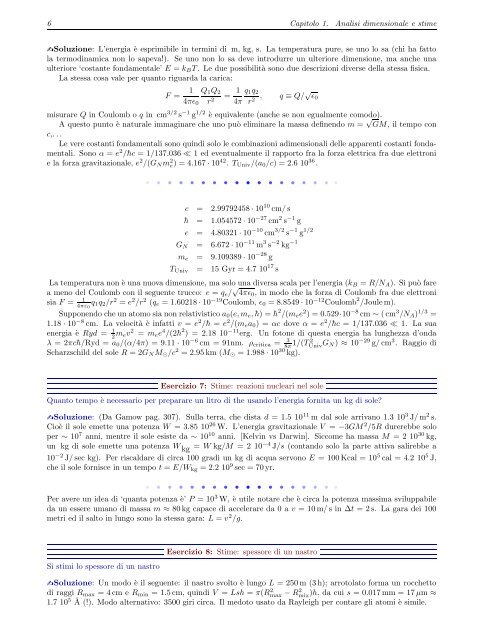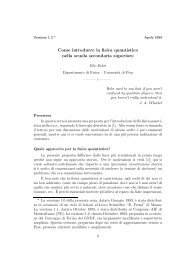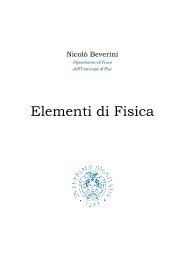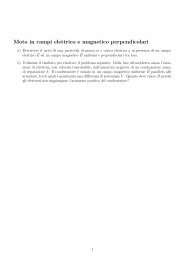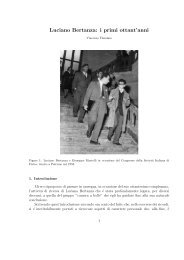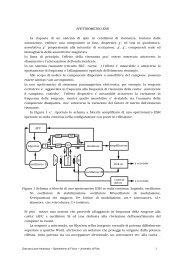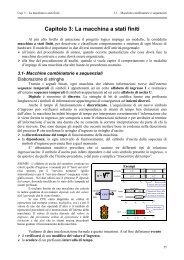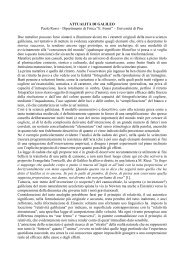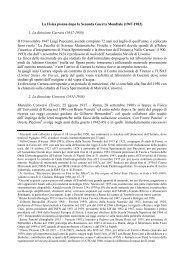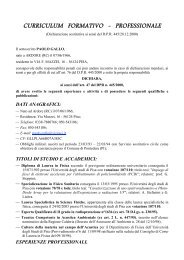Esercizi - Dipartimento di Fisica
Esercizi - Dipartimento di Fisica
Esercizi - Dipartimento di Fisica
You also want an ePaper? Increase the reach of your titles
YUMPU automatically turns print PDFs into web optimized ePapers that Google loves.
6 Capitolo 1. Analisi <strong>di</strong>mensionale e stime<br />
bSoluzione: L’energia è esprimibile in termini <strong>di</strong> m, kg, s. La temperatura pure, se uno lo sa (chi ha fatto<br />
la termo<strong>di</strong>namica non lo sapeva!). Se uno non lo sa deve introdurre un ulteriore <strong>di</strong>mensione, ma anche una<br />
ulteriore ‘costante fondamentale’ E = kBT . Le due possibilità sono due descrizioni <strong>di</strong>verse della stessa fisica.<br />
La stessa cosa vale per quanto riguarda la carica:<br />
F = 1 Q1Q2<br />
4πɛ0 r2 1 q1q2<br />
=<br />
4π r2 , q ≡ Q/√ɛ0 misurare Q in Coulomb o q in cm 3/2 s −1 g 1/2 è equivalente (anche se non egualmente comodo).<br />
A questo punto è naturale immaginare che uno può eliminare la massa definendo m = √ GM, il tempo con<br />
c,. . .<br />
Le vere costanti fondamentali sono quin<strong>di</strong> solo le combinazioni a<strong>di</strong>mensionali delle apparenti costanti fondamentali.<br />
Sono α = e 2 /¯hc = 1/137.036 ≪ 1 ed eventualmente il rapporto fra la forza elettrica fra due elettroni<br />
e la forza gravitazionale, e 2 /(GNm 2 e) = 4.167 · 10 42 . TUniv/(a0/c) = 2.6 10 36 .<br />
• • • • • • • • • • • • • • • • • •<br />
c = 2.99792458 · 10 10 cm/ s<br />
¯h = 1.054572 · 10 −27 cm 2 s −1 g<br />
e = 4.80321 · 10 −10 cm 3/2 s −1 g 1/2<br />
GN = 6.672 · 10 −11 m 3 s −2 kg −1<br />
me = 9.109389 · 10 −28 g<br />
TUniv = 15 Gyr = 4.7 10 17 s<br />
La temperatura non è una nuova <strong>di</strong>mensione, ma solo una <strong>di</strong>versa scala per l’energia (kB = R/NA). Si può fare<br />
a meno del Coulomb con il seguente trucco: e = qe/ √ 4πɛ0, in modo che la forza <strong>di</strong> Coulomb fra due elettroni<br />
sia F = 1<br />
4πε0 q1q2/r 2 = e 2 /r 2 (qe = 1.60218 · 10 −19 Coulomb, ɛ0 = 8.8549 · 10 −12 Coulomb 2 /Joule m).<br />
Supponendo che un atomo sia non relativistico a0(e, me, ¯h) = ¯h 2 /(mee 2 ) = 0.529·10 −8 cm ∼ ( cm 3 /NA) 1/3 =<br />
1.18 · 10 −8 cm. La velocità è infatti v = e 2 /¯h = e 2 /(mea0) = αc dove α = e 2 /¯hc = 1/137.036 ≪ 1. La sua<br />
energia è Ryd = 1<br />
2 mev 2 = mee 4 /(2¯h 2 ) = 2.18 10 −11 erg. Un fotone <strong>di</strong> questa energia ha lunghezza d’onda<br />
λ = 2πc¯h/Ryd = a0/(α/4π) = 9.11 · 10 −6 cm = 91nm. ρcritica = 3<br />
8π 1/(T 2 Univ GN ) ≈ 10 −29 g/ cm 3 . Raggio <strong>di</strong><br />
Scharzschild del sole R = 2GNM⊙/c 2 = 2.95 km (M⊙ = 1.988 · 10 30 kg).<br />
<strong>Esercizi</strong>o 7: Stime: reazioni nucleari nel sole<br />
Quanto tempo è necessario per preparare un litro <strong>di</strong> the usando l’energia fornita un kg <strong>di</strong> sole?<br />
bSoluzione: (Da Gamow pag. 307). Sulla terra, che <strong>di</strong>sta d = 1.5 10 11 m dal sole arrivano 1.3 10 3 J/ m 2 s.<br />
Cioè il sole emette una potenza W = 3.85 10 26 W. L’energia gravitazionale V = −3GM 2 /5R durerebbe solo<br />
per ∼ 10 7 anni, mentre il sole esiste da ∼ 10 10 anni. [Kelvin vs Darwin]. Siccome ha massa M = 2 10 30 kg,<br />
un kg <strong>di</strong> sole emette una potenza W kg = W kg/M = 2 10 −4 J/s (contando solo la parte attiva salirebbe a<br />
10 −2 J/ sec kg). Per riscaldare <strong>di</strong> circa 100 gra<strong>di</strong> un kg <strong>di</strong> acqua servono E = 100 Kcal = 10 5 cal = 4.2 10 5 J,<br />
che il sole fornisce in un tempo t = E/Wkg = 2.2 10 9 sec = 70 yr.<br />
• • • • • • • • • • • • • • • • • •<br />
Per avere un idea <strong>di</strong> ‘quanta potenza è’ P = 10 3 W, è utile notare che è circa la potenza massima sviluppabile<br />
da un essere umano <strong>di</strong> massa m ≈ 80 kg capace <strong>di</strong> accelerare da 0 a v = 10 m/ s in ∆t = 2 s. La gara dei 100<br />
metri ed il salto in lungo sono la stessa gara: L = v 2 /g.<br />
Si stimi lo spessore <strong>di</strong> un nastro<br />
<strong>Esercizi</strong>o 8: Stime: spessore <strong>di</strong> un nastro<br />
bSoluzione: Un modo è il seguente: il nastro svolto è lungo L = 250 m (3 h); arrotolato forma un rocchetto<br />
<strong>di</strong> raggi Rmax = 4 cm e Rmin = 1.5 cm, quin<strong>di</strong> V = Lsh = π(R2 max − R2 mix )h, da cui s = 0.017 mm = 17 µm ≈<br />
1.7 105 ˚A (!). Modo alternativo: 3500 giri circa. Il medoto usato da Rayleigh per contare gli atomi è simile.


